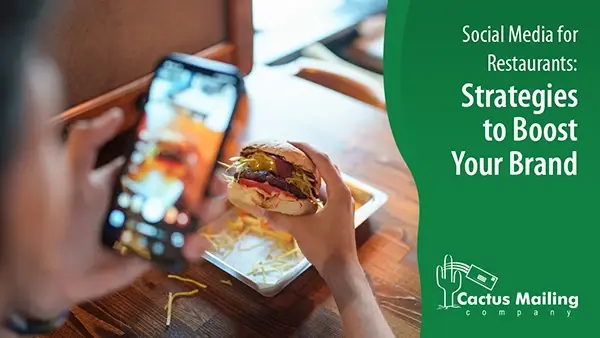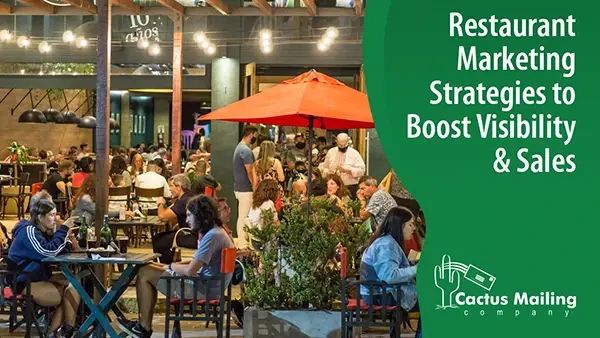We Are Here to Help!
What to Expect from Us:
No Pressure, Just Service!
Get no obligation pricing details and strategies that will work for your business.
Your restaurant's success hinges on the quality of your dishes and the strength of your marketing strategy. Social media marketing for restaurants has emerged as a vital tool for amplifying your brand and connecting with customers. By cultivating a robust social media presence, you're opening the door to a global dining room, giving people a tantalizing glimpse of the experiences you offer.
Developing a creative and engaging restaurant social media strategy and marketing plan can transform passive onlookers into enthusiastic patrons. Platforms such as Instagram and Facebook are particularly conducive to showcasing your culinary creations, promoting special offers, and building a community around your brand. An effective strategy ensures that your restaurant is the first place they think of when potential customers crave an eating adventure.
Establishing your restaurant on various social networks requires understanding each platform's unique features and audiences. Bold imagery, strategic use of trending hashtags, and interaction with user-generated content are just a few methods that amplify your visibility. Remember that every post is an opportunity to reflect the essence of your restaurant and entice diners to walk through your doors.
Establishing Your Brand on Social Media
Social media platforms offer unparalleled opportunities to cement your restaurant's brand identity and connect with customers. To harness their full potential, do the following:
Create Engaging Profiles
To establish your restaurant on top social platforms like Facebook, Instagram, and X (Twitter), your first step is to craft profiles that capture attention. Your social media profile picture should feature your restaurant's logo prominently, ensuring instant brand recognition. Optimize your bio by eloquently describing what makes your eatery unique. Remember to include essential details like location and hours.
Build a Cohesive Brand Voice
Your restaurant's brand voice should be consistent across all social media channels. Whether friendly, sophisticated, or quirky, this voice reflects your brand's personality and values. Keep messaging coherent, whether tweeting a daily special or describing a new menu item on Instagram—consistency breeds familiarity and trust.
Understand Your Target Audience
To effectively connect with your audience through social media algorithms, dive into the demographics of your customer base. Are they young professionals or families? Use insights from social platform analytics to tailor your content to their preferences. For instance, Instagram's visual platform is perfect for sharing mouth-watering images for a food-loving crowd. At the same time, Twitter can be used for snappy updates and engaging directly with customers to boost your brand awareness.

Content Strategy and Creation
Developing a content strategy for your restaurant's social media accounts entails the following to fit each platform's unique environment and audience.
Curating High-Quality Visual Content
Visuals are paramount in the food industry; your photos and videos should make a potential customer crave your menu items. When curating content for your restaurant's social media profiles, opt for professional-grade images that showcase your dishes in the best light. Keep your video content short, engaging, and mouth-watering for Instagram stories and reels. The pictures and clips need to reflect the atmosphere of your restaurant and the quality of your food, turning viewers into visitors.
Leveraging User-Generated Content
Encourage your patrons to share their experiences by creating a hashtag for your restaurant's social media strategy. Customer experiences create authentic social media content and build a community around your brand. Highlighting user-generated content fosters a sense of trust and loyalty, as customers appreciate seeing their content featured on your pages. Monitor tags and mentions and consider reposting customer stories with their permission.
Optimizing Content for Each Platform
Each social media platform has its quirks and preferred content types. Mix up your posts with high-resolution pictures, short videos, and stories for Instagram. On Twitter, witty captions and trendy hashtags can boost your engagement. Remember to adjust the dimensions and duration of your content to fit each platform's guidelines, ensuring that your food and menu items look enticing on all social media sites and channels.
Promotion and Advertising Techniques
It's crucial to understand the landscape of promotion and advertising. Mastering these techniques and creating engaging content can vastly increase your restaurant's visibility and attract more customers.
Integrating social proof, social media contests, targeted Instagram marketing, and consistent branding across all social media accounts is crucial for the success of your restaurant's social media marketing strategy.
Utilizing Social Media Advertising
You can tap into the power of social media advertising to target specific demographics and interests. Platforms like Facebook Pages allow you to tailor your advertising campaigns with precision. This means Facebook ads can put your restaurant in front of the eyes of those most likely to be interested in your cuisine. From setting up sponsored posts to tracking the performance of your ads, social media marketing tools enable you to measure the effectiveness of your campaigns, adjust your strategy, and manage your budget efficiently.
Special Offers and Events Promotion
For promotions and special offers, consider exclusive deals that followers can claim by engaging with your social media posts. This incentivizes people to follow your profiles and encourages them to visit your restaurant. Additionally, social media is a stellar platform for event marketing. Creating events on your Facebook page or Instagram lets you inform and excite your audience about upcoming happenings at your restaurant. Use striking visuals and clear details to enhance the appeal of your events and offers, driving both online engagement and offline traffic.

Engaging with Your Audience
Effectively engaging with your audience is crucial for building a loyal customer base and enhancing your online presence. Through strategic communication and attentive engagement, you can create a restaurant brand that resonates and encourages participation.
Managing Customer Reviews and Feedback
Customer reviews are a goldmine for feedback and provide direct communication between you and your patrons. Regularly monitor review platforms and your social media channels to respond to positive and negative comments quickly. Your timely, thoughtful responses showcase your commitment to customer satisfaction. Use a structured approach for consistency:
- Respond Promptly: Aim to reply to reviews within 24 hours.
- Acknowledge and Empathize: Show that you appreciate their feedback and understand any concerns.
- Take Action: Assure customers that their feedback is valued and used to make improvements.
Consistency in managing customer reviews fosters trust and encourages others to share their experiences, knowing that they will be heard.
Encouraging Conversations and Participation
Conversations are the heartbeat of social media engagement. Prompt your audience to interact by posting content that invites comments, questions, or shares. Consider these tactics:
- Ask Questions: Pose questions or polls about your menu or food preferences to encourage participation.
- User-Generated Content: Feature customer photos or stories with their permission, which can motivate others to join in.
- Exclusive Offers: Share special promotions or behind-the-scenes peeks to spark conversations and enhance engagement.
Growth and Outreach Strategies
Enhancing your restaurant's presence on social media calls for strategic planning and smart campaigning. Below are specific restaurant marketing tactics to help you grow your brand and reach more potential customers.
Influencer and Partner Collaborations
Partnering with social media influencers can amplify your restaurant's reach. Look for influencers with a genuine connection to your target audience, those who align with your brand values and have solid engagement rates. Collaborate on exclusive events where influencers can share their experiences with their audience, creating an authentic buzz around your restaurant.
Ideas for partnerships:
- Host a menu-tasting event and invite influencers to try new dishes.
- Arrange a cook-off competition and have influencers as guest judges.

Hashtag and Location-Based Marketing
Engage customers with creative hashtag campaigns that encourage user-generated content. Craft hashtags that are unique to your restaurant, memorable, and relevant to your brand. This enhances the restaurant's social media visibility and can become a fun way for patrons to interact with your business.
Implement location-based marketing by tagging your restaurant's location in your posts to appear in geo-specific searches. Urge your customers to check in or tag a social media post with your location when they visit, broadening your visibility to their network of friends and followers.
Checklist for hashtags and location tags:
- Use 5-10 relevant hashtags per post.
- Create a signature hashtag for your restaurant.
- Regularly post with your location tag to remain prominent in location searches.
Remember, these strategies are not one-size-fits-all. Tailor your approach to fit your brand's voice and audience.
Monitoring and Analytics for Improvement
Integrating social media monitoring and analytics into your marketing strategy can significantly enhance your restaurant's online presence and customer engagement. These tools provide valuable insights, helping you to adapt your approach for better results.
Understanding Social Media Insights
Social Media Insights allow you to gauge the performance of your content and understand your audience's preferences. Monitoring metrics such as engagement rates, reach, and follower growth lets you see what content resonates with your customers. For instance, you can identify popular menu items or promotional offers by analyzing customer feedback and interaction on posts. This data is critical in crafting a tailored social media strategy that aligns with your audience's interests.
Additionally, monitoring tools can highlight the best times to post and the most effective platforms for your specific demographic of social media users. By utilizing platforms such as Incentivio to manage your social media efforts, you can ensure that your content reaches the right people at the right time.
Adapting Strategies Based on Analytics
Once you've gathered analytics, the next step is to adapt and optimize your marketing strategies. Look at the data to determine patterns and trends. For example, if you notice particular types of content generating more engagement, producing similar content more frequently would be wise. On the other hand, low-performing posts can indicate what to avoid or tweak.
Analytics can also inform you about the customer journey and help you refine your advertising campaigns for better conversion rates. Tools offering detailed insights, such as LICERA, provide a deeper understanding of how your audience interacts with your brand across various social media platforms. By continually analyzing this data, you ensure ongoing improvements and a strategy that evolves with your customer's needs and preferences.
Maintaining an Active Online Presence
In the hospitality realm, your online presence is the digital face of your restaurant. Ensuring consistency in interaction and presence on social media platforms could be the difference between dwindling patronage and a bustling eatery.
Consistent Posting and Updates
To establish a strong foothold online, you must uphold a rhythm of consistent posting. This doesn't only mean frequent updates but also ensuring those updates reflect the current state of your restaurant, like an updated menu or upcoming events. It's important not to bombard your audience but instead find a balanced schedule that keeps your restaurant fresh in their minds.
Monday: Share a motivational quote with a breakfast special.
Wednesday: Preview mid-week offers or a behind-the-scenes look.
Friday: Promote the weekend's special dish.
Sunday: Post a casual reminder of your hours for the upcoming week.

Real-Time Communication
Engaging with your customers in real-time on social media platforms builds trust and rapport. It shows you value their feedback and are responsive to their needs. This type of engagement can take many forms, such as promptly answering questions about menu items, reservation inquiries, or addressing customers' concerns. Doing so creates a sense of community and belonging among your patrons, which is invaluable for customer loyalty.
Maximizing Reach to Various Demographics
When approaching a social media marketing strategy for your restaurant, understanding the nuances of your target audience is essential. You'll craft strategies that resonate with different age groups and location-based customer segments.
Targeting Millennials and Gen Z
To effectively engage Millennials and Gen Z, tap into the trends and platforms where these demographics spend their time.
Millennials between the ages of 25 and 40 will likely be attracted to brands that showcase authenticity and social responsibility. Emphasize your restaurant's commitment to sustainability and community involvement.
Gen Z, the digital-savvy cohort under 24, looks for interactive and visually stimulating content. Utilize platforms like TikTok to create short, engaging videos showcasing your restaurant's atmosphere and dishes, effectively turning viewers into potential diners.
Engaging Tourists and Local Customers
Your restaurant marketing strategy should consider the location of your restaurant to attract tourists and local customers.
For tourists: Use geotagging and location-based hashtags to make your content discoverable to those exploring your area. Highlight unique local ingredients or dishes that offer them an authentic experience.
Local customers are the backbone of your business. Engage with them by featuring local events or by partnering with neighborhood businesses. You could create a buzz around your restaurant by involving yourself in local happenings, which, according to LinkedIn, could enhance your visibility and reach within the community.
Technology and Tools for Efficient Management
In harnessing the power of social media for your own restaurant business, selecting the right technology and tools is crucial for streamlining your digital marketing efforts and maintaining open communication with your customers.
Using Social Media Management Tools
When you leverage social media management tools, you can seamlessly oversee multiple accounts across various platforms. Tools like Hootsuite allow you to schedule posts, track engagement, and measure the success of your campaigns—all from one dashboard. Choosing a tool that integrates with your existing workflows can significantly reduce the time and effort required to maintain a strong online presence.
Features to look for in a social media management tool:
- Post scheduling
- Engagement analytics
- Multi-platform integration
- Collaboration capabilities
Choosing a robust social media management tool like SocialPilot elevates your brand's visibility. It can help tailor your messaging to appeal to your specific audience.
Automating Engagement with Customers
Your social media strategy should include automated engagement features to maintain open communication with customers. Automating responses to comments and messages ensures that your customers receive timely interactions, reflecting positively on your customer service. Look for tools that allow you to create personalized auto-responses that align with your brand's tone.
Benefits of automating customer engagement:
- Faster response times
- Consistent communication
- Improved customer satisfaction
Incorporating automated tools into your strategy creates a more engaging and responsive online environment that encourages customer loyalty and frequent communication. Remember, the goal is to make your customers feel heard and valued without overburdening your team.

Conclusion
A restaurant owner should view social media marketing for restaurants as an essential aspect of modern hospitality. Leveraging the strengths of different platforms creates a solid social media presence and effective online marketing. It plays a pivotal role in enhancing brand awareness and customer engagement.
Platform-specific social media campaign optimization helps a restaurant brand attract and retain new customers. Additionally, the use of social media advertising, special offers, and event promotions are effective methods to increase visibility and engagement.
Your social media channel can also utilize influencer marketing, hashtag campaigns, and location-based marketing to broaden your reach. As a restaurant owner, you can maximize your account by following these social media marketing tips to enhance overall efficiency and customer satisfaction through your restaurant marketing.
Our direct mail postcards have helped various businesses get leads, boost awareness, and grow revenue. Let us help you create a restaurant marketing postcard design to achieve your goals!
Start your postcard marketing journey with us today!

 Cactus Mail Team: Jul 03, 2024
Cactus Mail Team: Jul 03, 2024



